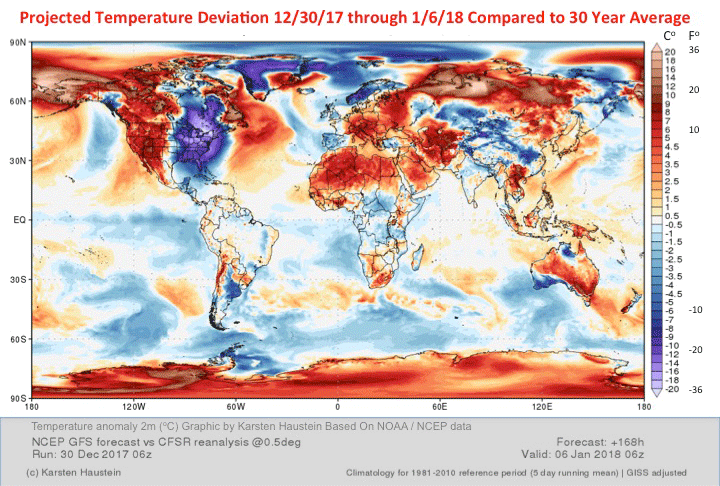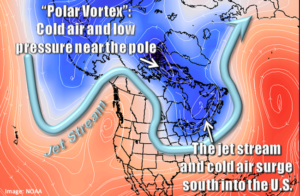Why Freezing Temps Are Due to Warming
Freezing temperatures have hit the Eastern U.S. big time, with temperatures more than twenty degrees Fahrenheit below normal. (Even President Trump joked that “global warming” might be a good thing — rather interesting since he has labeled it a hoax.) What’s going on? Does the freezing contradict climate change, a/k/a global warming? Not at all.
Let’s look at the facts. Above is a global graphic generated the morning of December 30th, for the next seven days. It shows temperature projections compared to the historical averages of the last three decades. The story of this extreme cold weather can be seen here, if you know where to look. (To clarify terms,the short term, weekly variations are considered weather, and the 30-year picture gives a climate perspective, which is very long-term weather patterns.)
Keeping it simple, here are the points to note in the graphic:
- Temperature colors depict the average temperature forecast for the coming week, compared to the recent three decades (1980-2010). As shown in the legend at the right, the blue shades are colder and the red shades are warmer. (Note these are variations from average, not actual temperatures.)
- The Eastern US is really cold today and through the coming week, but is the exception to the entire planet, which overall is MUCH warmer than usual. The Eastern US and Eastern Canada are indeed about 20 degrees F colder than normal.
- However, notice that Western North America, Alaska, the Arctic Ocean, Eastern Europe, Northern Asia, the Middle East, North Africa, most of Australia and Antarctica are all about 20 degrees warmer than normal. It is easy to see that is most of the planet.
- Our expectations for “normal weather” are based on long term patterns that associate with the various seasons. The stability and predictability comes from the standard circulation pattern of the ocean and atmospheric currents such as the Jet Stream and the Gulf Stream, respectively. For thousands of years, those have exhibited ritual patterns. However now that the planet is about 1.5 degrees F (one degree C) warmer than previous centuries, those currents are changing.
- A major culprit for changes in patters is the truly strange weather is the Arctic Ocean. It has been frozen for millions of years. As most are aware it is thawing quickly, to the point where ships are already able to plan routes during the warmer months. The area and duration of the ice-free Arctic Ocean keeps increasing even now in the middle of winter.
- Even though the water up the high Arctic is very cold, the lack of thick sea ice changes everything. The vast heat energy in the ocean would normally be insulated or blocked by the ice barrier, limiting its affect on the atmosphere. As the ice barrier gets smaller and smaller, more heat gets into the atmosphere. In turn, that energy is disrupting the normal patterns of atmospheric currents such as the Jet Stream.
- As the Jet Stream meanders and destabilizes, it allows the warmer air masses to move north, sometimes pushing or displacing colder air masses further south somewhat unpredictably.
- As illustrated at right, that is what is now called the “Polar Vortex”, as area of freezing cold air that dips south from time to time. This is what the Eastern US is now experiencing. At the simplest level, huge growth in warm air masses will push some of the cold air masses out of their normal location.
The bottom line:
- As we put more and more heat energy into the sea (where 90%+ of the excess heat gets stored) ocean and atmospheric circulation will continue to change, in ways that are hard to predict.
- While the overall pattern will be WARMING, the disturbed air currents will cause some small exceptional areas of cold weather. Such disturbances from “normal weather” have always been part of the models with climate change and global warming — including some extremes, such as we are now experiencing.
- While we tend to focus on the temperate and tropical zones where the vast majority of humans live, we also need to stay focused on the two polar regions. They hold the keys to future change. The changing Arctic will be the big disruptor for weather patterns. The changing Antarctic will be the big disruptor for rising sea level as the glaciers thaw more and more quickly. And note how warm Antarctica is.
So for New Year’s week, stay indoors or bundle up if you happen to live in the freezing Eastern US or Canada. Everywhere else, have your shorts and sunscreen handy.
Best wishes for 2018.


